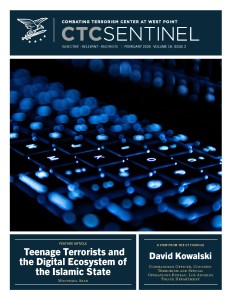From the Editor
In this month’s feature article, Moustafa Ayad examines 93 unofficial Islamic State groups and outlets operating across social media platforms and messaging applications to understand how the Islamic State’s digital ecosystem is fostering teenage terrorism. He writes that an “ecosystem of unofficial Islamic State groups and their supporters are continuing to flaunt their ability to use social media platforms for recruitment and propaganda” with youngsters “interacting with and producing Islamic State content in new shapes and forms.” He adds that the unofficial Islamic State propagandists are “finding innovative, low budget hacks to the hurdles placed in their way by social media companies and messaging applications. The Islamic State’s digital ecosystem is thriving, and the outlets within it are not just flaunting an ability to game platforms, but are similarly expanding their presence onto new emerging applications, allowing them to fight off coordinated efforts and automated approaches intended to stop their spread.”
Our interview is with Deputy Chief David Kowalski, the commanding officer of the Counter-Terrorism and Special Operations Bureau at the Los Angeles Police Department. His department is increasingly focused on keeping the upcoming Olympics in the city safe. He says: “We’ve been preparing for the 2028 Olympics for the past seven years. Each year, our preparation and development becomes more advanced. We work closely with all the agencies throughout the city, which includes our mayor’s office, the fire department, our federal agencies, the emergency management department of the city, and it’s a whole regional approach to making sure these games are successful.” He adds: “We’ve worked very closely with our partners in Paris this past summer. … From a counterterrorism point of view, we’ve had the opportunity to look at what worked in Paris and in lessons learned, and that’s been very beneficial to us as we move into 2028.” He further notes that “the threats to Los Angeles and the rest of the country continue to become more sophisticated. Over the past six years working in the field, the threat environment has never been so diverse and changing, and we must remain ahead of how these threats can impact our cities.”
Munira Mustaffa provides a case study of the May 2024 Ulu Tiram attack in Malaysia. She writes that the attack “illuminates how an isolated familial environment, driven by a fanatical father’s extreme religious ideology, systematically groomed the attacker through a distorted theological narrative that reframed violence as a spiritual purification ritual and pathway to salvation.” She adds that the case study demonstrates “how self-imposed ideological exiles can create significant challenges for monitoring and intervention, thus underscoring the urgent need for sophisticated approaches that move beyond simplistic categorizations of terrorist sympathizers.”
Paul Cruickshank, Editor-in-Chief
 Skip to content
Skip to content

